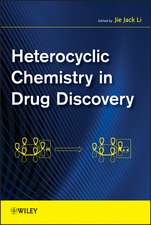Rational Design of Stable Protein Formulations: Theory and Practice: Pharmaceutical Biotechnology, cartea 13
Editat de John F. Carpenter, Mark C. Manningen Limba Engleză Hardback – 30 apr 2002
This book describes the current level of understanding of protein instability and the strategies for stabilizing proteins under a variety of stressful conditions.
| Toate formatele și edițiile | Preț | Express |
|---|---|---|
| Paperback (1) | 1090.61 lei 43-57 zile | |
| Springer Us – 30 oct 2012 | 1090.61 lei 43-57 zile | |
| Hardback (1) | 1097.54 lei 43-57 zile | |
| Springer Us – 30 apr 2002 | 1097.54 lei 43-57 zile |
Preț: 1097.54 lei
Preț vechi: 1155.30 lei
-5% Nou
Puncte Express: 1646
Preț estimativ în valută:
210.08€ • 228.27$ • 176.58£
210.08€ • 228.27$ • 176.58£
Carte tipărită la comandă
Livrare economică 21 aprilie-05 mai
Preluare comenzi: 021 569.72.76
Specificații
ISBN-13: 9780306467417
ISBN-10: 0306467410
Pagini: 206
Ilustrații: XVII, 206 p.
Dimensiuni: 155 x 235 x 14 mm
Greutate: 0.5 kg
Ediția:2002
Editura: Springer Us
Colecția Springer
Seria Pharmaceutical Biotechnology
Locul publicării:New York, NY, United States
ISBN-10: 0306467410
Pagini: 206
Ilustrații: XVII, 206 p.
Dimensiuni: 155 x 235 x 14 mm
Greutate: 0.5 kg
Ediția:2002
Editura: Springer Us
Colecția Springer
Seria Pharmaceutical Biotechnology
Locul publicării:New York, NY, United States
Public țintă
ResearchCuprins
1 Practical Approaches to Protein Formulation Development.- Preparation for Formulation Development.- Preformulation Development.- Formulation Development.- Formulation in Commercial Product Development.- Appendix: List of Regulatory Documents.- References.- 2 Recombinant Production of Native Proteins fromEscherichia coli.- Distribution of Expressed Proteins.- Cell Washing and Lysis.- Purification of Soluble, Folded Proteins.- Purification and Refolding of Soluble, Misfolded Proteins.- Purification and Refolding of Proteins from Inclusion Bodies.- Refolding Mechanism.- Methods to Analyze Folded Structures.- References.- 3 Physical Stabilization of Proteins in Aqueous Solution.- Overview of Physical Stability.- Interactions of Excipients with Proteins.- Physical Factors Affecting Protein Stability.- Conclusions.- Appendix: Derivation of the Wyman Linkage Function and Application to the Timasheff Preferential Exclusion Mechanism.- References.- 4 Effects of Conformation on the Chemical Stability of Pharmaceutically Relevant Polypeptides.- Relationship Between Structure and Deamidation Rates.- Role of Structure in Protein Oxidation.- Summary.- References.- 5 Rational Design of Stable Lyophilized Protein Formulations: Theory and Practice.- Minimal Criteria for a Successful Lyophilized Formulation.- Rational Design of Stable Lyophiilized Formulations.- Acknowledgments.- References.- 6 Spray-Drying of Proteins.- Introduction: Why Spray-Dry a Protein?.- Developments in the Last 10 Years.- The Practice of Spray-Drying Proteins.- Concluding Remarks.- References.- Chapter7 Surfactant-Protein Interactions.- Proteins and Surfactants at Surfaces.- Protein-Surfactant Interactions in Solution.- Surfactant Effects on Protein Assembly State.- Surfactant Effects on Proteins During Freezing, Freeze-Drying and Reconstitution.- Enzymatic Degradation of Non-Ionic Surfactants.- Recommendations for Protein Formulation.- References.- 8 High Throughput Formulation: Strategies for Rapid Development of Stahle Protein Products.- Overall Structure of the HTF Approach.- Role of an Established Decision Tree for Formulation Design.- Use of Software and Databases to Assist in the HTF Process.- Essential Analytical Methods.- Stability Protocols.- Unified Strategy for HTF.- References.






















